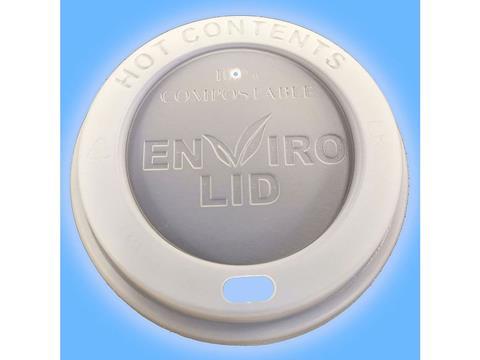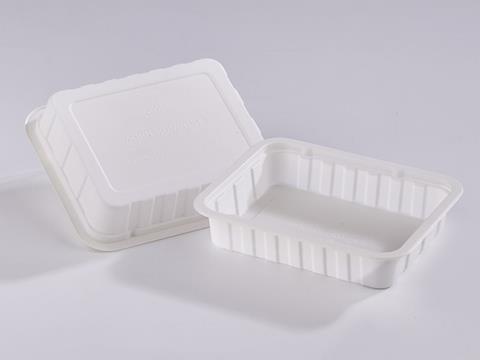
Are biobased and biodegradable plastics also suitable for thermoforming? Find out in this case study by FKuR in an English language exclusive for Packaging Europe.
The Turkish plastics processor Göncay Plastik, who manufactures millions of plastic lids for drinking cups for fast-food chains, answers the question with a definite "yes". The company has plenty of good experience with Bio-Flex®, a biobased compound from the portfolio of FKuR that meets the high specifications on processability and product properties.
The application of plastics in the packaging segment, which is frequently characterised by extremely large production runs, is at the centre of discussion more than ever before. Proven ways to gain greater acceptance include the use of recycling-friendly monolayer structures and the lowering of material consumption by reducing the thickness and thus the weight of the product. A lesser known aspect here is that biobased thermoplastics are also suitable for one of the most commonly used production processes in the industry, namely thermoforming – also known as vacuum forming. The products combine an aesthetic appearance with functionality plus a significant increase in sustainability.
Millions of lids for hot and cold drinks
Göncay Plastik reports on the successful use of a thermoformed product from a biobased thermoplastic instead of a conventional thermoplastic. The company, founded in 1988, is headquartered in Istanbul and delivers to customers in over 50 countries, predominantly in Europe. One of its biggest-selling products is a range of thermoformed plastic lids for hot and cold drink cups for international fast-food chains. With a production capacity of 6 million lids a day, Göncay Plastik manufactures over 70 different shapes and sizes for virtually all types of plastic cups and beakers used around the world. In 2018 the company switched part of this production to the product Bio-Flex® S 7711 from FKuR.
Managing Director Ibrahim Göncay remembers well how it all started: "We received the assignment from our customers – belonging to the best-known branded companies in the world – to maximise the environmental compatibility of our products by reducing the amount of material used and by deploying sustainable materials. In order to come up with the right answers, we turned to Mert Kumru from Kumru Kimya (www.kumrukimya.com), the local representative of FKuR. We then received sample materials for pilot trials and extensive application-related assistance during the sampling process."
The result of this cooperation was that Bio-Flex® S 7711 proved to be the best-suited material for the production of the thermoformed lids. Kumru: "Bio-Flex® S 7711 combines the high elasticity that is required for easy pressing of the lid onto the beaker with the necessary stiffness and rigidity for a firm and reliable fit despite the low wall thickness. It naturally also has the required heat resistance and heat deflection temperature. However, in the end, the real solution to the task only came about through the combination of these beneficial material properties with some process modifications that affected both the extrusion line for the film manufacture and the thermoforming station." As Göncay further reported, production of the lids has been running without a single customer complaint since it was switched to Bio-Flex®.
The right material for every task
Thermoforming is a highly economical process for the million-fold manufacture of products such as the previously mentioned beaker lids as well as blister packs and trays. In all cases, the first step is to heat up a two-dimensional plastic film or sheet and then, under a vacuum or with compressed air, press it against the contours of a mould. This results in the three-dimensional mouldings, predominantly for the packaging segment, but also for the toy, consumer goods and automotive industries, as well as many other segments.
Basically, all thermoplastics are suitable for thermoforming, which means that a appropriate material – from commodities to high-performance plastics – exists for every project. FKuR meets the need for biobased types with certain Bio-Flex® PLA blends, with a partially biobased PET and also with a biobased HDPE.
Flexible, biobased and biodegradable

Bio-Flex® products are blends from FKuR's own development centre. They are based on PLA (polylactic acid) and thus consist entirely or partially of natural raw materials. They are also entirely biodegradable (according to EN 13432). Through the choice of related additional polymers, all grades are significantly more flexible than the rather brittle pure PLA. In addition to the Bio-Flex® S 7711 used at Göncay, Bio-Flex® F 6611, F 6711 and F 7510 as well as S 5630 WH are specifically suitable for thermoforming. Furthermore, according to EN 10/2011, they are also all suitable for use as packaging materials for food contact applications.
Bio-Flex® S 7711 combines high stiffness and strength as a prerequisite for particularly thin-walled yet stable thermoformed parts. It has the highest elongation at break of this product family, allowing high plasticity and forming characteristics combined with good resilience properties.
Bio-Flex® F 6611 is a certified GMO-free type. It is noted for its pleasant tactile properties and pearlescent gloss. Furthermore, it satisfies the criteria of standard EN 13432 and is thus classified as a certified compostable material. Typical applications include food trays and coffee capsules. Furthermore, Bio-Flex® F 6711, which has similar properties, is also suitable for applications with acidic foodstuffs such as fruit.
Bio-Flex® F 7510 has a lower density than the F 6611 and F 6711 grades. Accordingly, its stiffness and strength are closer to those of pure PLA Typical applications for this grade include cold drink lids.
Bio-Flex® S 5630 WH is noted for its balanced ratio of extensibility and stiffness. Furthermore, products made from this grade have pleasant, high-quality tactile properties. The most common application apart from trays is caps for coffee capsules.
Biobased and highly transparent
A partially biobased PET suitable for the production of thermoformed film in FKuR's product portfolio is Eastlon PET CB-602AB produced by the Taiwanese Fenc Group. It is chemically identical to conventional fossil based PET and consists 70 % of terephthalic acid and 30 % of biobased monoethylene glycol (Bio-MEG). The basis for the Bio-MEG used here is, however, ethanol, which is obtained from the renewable vegetable raw material, sugar cane.
The properties and processing of Eastlon correspond to those of conventional PET. Like the latter, it can be printed, punched, embossed and bonded, and it also combines high optical clarity with good resistance to a variety of chemicals and oils. For this reason, Eastlon CB-602AB has proved itself as a drop-in solution in a variety of thermoforming applications, for which conventional PET was previously used, including above all transparent packaging solutions. In existing PET material flows, it is completely recyclable.
Polyethylene from sugar cane
The product Green HDPE SHE 150 in FKuR's portfolio, which is suitable for the production of film and subsequent thermoforming, is a member of the biobased "I’m green™" PE family from Braskem, which is produced on the basis of sugar cane. The recyclability and mechanical properties correspond to those of conventional HDPE from crude oil, which means that this material can also serve as a drop-in product. The proportion of renewable raw materials in Green HDPE SHE 150 is 94 %.
Much stronger demand expected
Ibrahim Göncay from Göncay Plastic sees a clear trend towards an increase in the demand for such products: "At the moment, the limited availability and the price are putting a brake on the use of biobased thermoplastics. But I am confident that the packaging segment in particular will react to the current lively discussion about the use of plastics and will increasingly turn to biobased varieties in the near future. I also believe that the market availability of biobased plastics will play an important role in implementing the impending changeover."

















